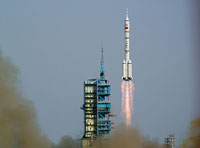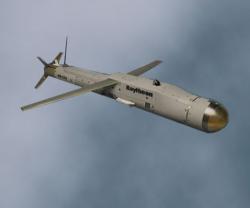China will deploy bigger spacecraft for longer missions following the success of its Shenzhou 9 voyage, allowing it to build a manned space station and potentially put a man on the moon, experts said.
The 13-day voyage of Shenzhou-9, which returned to Earth on Friday, was China's longest-ever space mission and included the nation's first woman astronaut among its three crew members.
In another first for China's 20-year space program, which has cost more than $6 billion, the crew also achieved the country's first-ever manual docking with an orbital module, the Tiangong-1, a high-speed and high-risk maneuver.
In the next mission that will occur at the end of this year or in 2013, Shenzhou-10's astronauts will link up with Tiangong 1 in a similar flight, said Morris Jones, an Australian space expert focusing on China's program.
The mission will be the last docking with the Tiangong-1, which was put into orbit in September last year.
Morris said no more astronauts would go on Tiangong-1 after the next mission. Then, in a few years, China will launch a more sophisticated version, the Tiangong-2.
When that comes into play, the dimensions of China's space program will grow significantly, said Isabelle Sourbes-Verger, a specialist on China's space program at France's National Centre for Scientific Research.
She said future vehicles would allow for larger space modules, longer missions and more powerful launch vehicles,
China is also developing the Long March 5, a next-generation booster rocket that will be needed if the nation hopes to place a bigger space station in orbit, said Joan Johnson-Freese, a professor at the US Naval War College.
“I would expect to see this large space station in orbit within the next 10 years -- which could make it the de facto replacement for the now orbiting International Space Station (ISS),” said Johnson-Freese.
She was referring to the life expectancy of the ISS -- run by the American, Russian, Japanese, European and Canadian Space Agencies -- which is likely to function only to around 2020. China has never been invited to join the ISS.
Sourbes-Verger said further advances in China's space station program would “guarantee” that the country plays a major role should any eventual cooperation with the ISS take place.
To realize its ambitions beyond 2020, which may include sending a man to the moon, China has also been advancing its “Chang'e” exploration program. This entails satellite launches to explore the lunar surface.
“Likely within the next five to eight years China will also make a decision as to whether to pursue a human lunar mission,” Johnson-Freese said.
Meanwhile the United States, after retiring its space shuttle fleet, is also developing a new rocket and technologies to place a man on an asteroid or on Mars, she said.
“Both countries are moving forward, but not in a competitive path,” she said.
China's space program remains far behind the Americans. This was highlighted by the fact that the manual space docking trumpeted by the Chinese on the Shenzhou-9 mission was done by the Americans in the 1960s.
Source: AFP






















